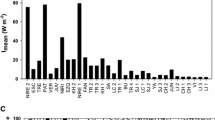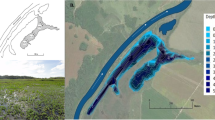Abstract
Total phosphorus and total nitrogen explained a low percentage of summer chlorophyll variability in epilimnia of the Great Masurian Lakes. Division of the whole data set into two subgroups of lakes improved approximation of the chlorophyll nutrient relationship but revealed also functional differences between the lakes distinguished in that way. Chlorophyll in eutrophic lakes correlated well with nitrogen and phosphorus, that in mesotrophic lakes (those with summer chlorophyll <=22 mg m−3 as calculated in the model) was related to none of the nutrients. Higher summer chlorophyll content in epilimnetic waters was accompanied by higher chl:PP and chl:PN ratios. Algal adaptation to poor light conditions in eutrophic lakes is postulated as a possible reason for that difference.
Chlorophyll – nutrient relationships varied with the trophic status of lakes. Epilimnetic chlorophyll strictly followed phosphorus changes in eutrophic lakes but did not do so in mesotrophic ones. Detailed comparison of selected meso- and eutrophic lakes showed marked differences in the seasonal changes of chlorophyll and nutrient concentrations and in sedimentation rates, especially in spring. Nutrient limitation rather than zooplankton grazing is suggested as a possible mechanism of controlling algal abundance and the sequence of spring events in a eutrophic lake. It is hypothesised that phosphorus turnover in eutrophic lakes is dominated by seasonal vertical fluxes, while in mesotrophic lakes it is more conservative with consumption and regeneration restricted mostly to metalimnion. Possible consequences of such conclusion are discussed in the paper.
Similar content being viewed by others
References
Baines, S. B. & M. L. Pace, 1994. Relationship between suspended particulate matter and sinking flux along a trophic gradient and implications for the fate of planktonic primary production.. Can. J. Fish. aquat. Sci. 51: 25–36.
Carlson, R. E., 1977. A trophic state index for lakes. Limnol. Oceanogr. 22: 361–369.
Chapman, D., 1992. Water quality assessment. A guide to the use of biota, sediments and water in environmental monitoring. Chapman & Hall, London: 585 pp.
Dillon, P. J. & F. H. Rigler, 1974. The phosphorus-chlorophyll relationships in lakes. Limnol. Oceanogr. 19: 767–773.
Elser, J. J., 1992. Phytoplankton dynamics and the role of grazers in Castle Lake, California. Ecology 73: 887–902.
Elser, J. J. & C. R. Goldman, 1991. Zooplankton effects on phytoplankton in lakes of contrasting trophic status. Limnol. Oceanogr. 36: 64–90.
Gibson, C. E., R. H. Foy & A. E. Bailey - Watts, 1996. An analysis of the total phosphorus cycle in some temperate lakes: the response to enrichment. Freshwat. Biol. 35: 525–532.
Golterman, H. L., 1969. Methods for chemical analyses of fresh waters. Blackwell Scientific Publications, Oxford and Edinburgh: 172 pp.
Hansson, L-A., 1992. The role of food chain composition and nutrient availability in shaping algal biomass development. Ecology 73: 241–247.
Hillbricht-Ilkowska, A., 1993. Phosphorus loading to lakes of Suwałki Landscape Park (north-eastern Poland) and its relation to lake trophy indices. Ekol. pol. 41: 221–235.
Hillbricht-Ilkowska, A. & R. J. Wiœniewski, 1993. Trophic differentiation of lakes of the Suwałki Landscape Park (north-eastern Poland) and its buffer zone - present state, changes over years, position in trophic classification of lakes. Ekol. pol. 41: 195–219.
Kufel, L., 1998. Chlorophyll-nutrients-Secchi disc relationships in the Great Masurian Lakes (north-eastern Poland). Pol. J. Ecol. 46: 327–337.
Kufel, L., 1999. Dimictic versus polymictic masurian lakes: similarities and differences in chlorophyll - nutrients - SD relationships. Hydrobiologia 408/409 (Dev. Hydrobiol. 143): 389–394.
Kufel, L. & K. Kalinowska, 1997. Metalimnetic gradients and the vertical distribution of phosphorus in a eutrophic lake. Arch. Hydrobiol. 140: 309–320.
Lampert, W., W. Fleckner, H. Rai & B. E. Taylor, 1986. Phytoplankton control by grazing zooplankton: A study on the spring clear-water phase. Limnol. Oceanogr. 31: 478–490.
Mazumder, A., 1994 a. Phosphorus-chlorophyll relationships under contrasting herbivory and thermal stratification: predictions and patterns. Can. J. Fish. aquat. Sci. 51: 390–400.
Mazumder, A., 1994 b. Phosphorus-chlorophyll relationships under contrasting zooplankton community structure: potential mechanisms. Can. J. Fish. aquat. Sci. 51: 401–407.
Mazumder, A., 1994 c. Patterns of algal biomass in dominant oddvs. even-link ecosystems. Ecology 75: 1141–1149.
McCauley, E., J. A. Downing & S. Watson, 1989. Sigmoid relationships between nutrients and chlorophyll among lakes. Can. J. Fish. aquat. Sci. 46: 1171–1175.
Persson, L., G. Andersson, S. F. Hamrin & L. Johansson, 1988. Predator regulation and primary production along the productivity gradient of temperate lake ecosystems. In Carpenter, S. R. (ed.), Complex Interactions in Lake Communities. Springer-Verlag, New York: 45–65.
Prairie, Y. T., C. M. Duarte & J. Kalff, 1989. Unifying nutrient - chlorophyll relationships in lakes. Can. J. Fish. aquat. Sci. 46: 1176–1182.
Pridmore, R. D., J. E. Hewitt & A. B. Cooper, 1989. Does the chlorophyll a content of phytoplankton vary with trophic status in lakes on the New Zealand central volcanic plateau? J. Plankton Res. 11: 583–593.
Reynolds, C. S., 1992. Eutrophication and the management of planktonic algae: what Vollenweider couldn't tell us. In Sutcliff, D. W. & J. G. Jones (eds), Eutrophication: Research and Application to Water Supply. Freshwater Biological Association: 4–29.
Sakamoto, M., 1966. Primary production by phytoplankton community in some Japanese lakes and its dependence on lake depth. Arch. Hydrobiol. 62: 1–28.
Sas, H., 1989. Lake restoration by reduction of nutrient loading. Expectations, experiences, extrapolations. Academia Verlag Richarz, Sankt Augustin: 497 pp.
Scheffer, M., 1998. Ecology of shallow lakes. Chapman & Hall, London, Weinheim, New York: 357 pp.
Seip, K. L. & H. Goldstein, 1994. Different response to changes in phosphorus, P, among lakes. A study of slopes in chl a = f(P) graphs. Hydrobiologia 186: 27–36.
Smith, V. H., 1982. The nitrogen and phosphorus dependence of algal biomass in lakes: an empirical and theoretical analysis. Limnol. Oceanogr. 27: 1101–1112.
Solórzano, L., 1969. Determination of ammonia in natural waters by the phenylhypochlorite method. Limnol. Oceanogr. 14: 799–800.
Sommer, U., Z. M. Gliwicz, W. Lampert & A. Duncan, 1986. The PEG model of seasonal succession of planktonic events in fresh Waters. Arch. Hydrobiol. 106: 433–471.
Standard Methods for the Examination of Water and Wastewater 1960). Am. Publ. Health Assoc. Inc., New York: 626 pp.
Uchmañski, J. & W. Szeligiewicz, 1988. Empirical models for predicting water quality as applied to data on lakes of Poland. Ekol. pol. 36: 285–316.
White, E., G. Payne & S. Pickmere, 1988. A limitation to the usefulness of chlorophyll as a biomass indicator in eutrophication studies. Verh. int. Ver. Limnol. 23: 598–601.
Zdanowski, B., 1982. Variability of nitrogen and phosphorus contents and lake eutrophication. Pol. Arch. Hydrobiol. 29: 541–597.
Author information
Authors and Affiliations
Rights and permissions
About this article
Cite this article
Kufel, L. Uncoupling of chlorophyll and nutrients in lakes – possible reasons, expected consequences. Hydrobiologia 443, 59–67 (2001). https://doi.org/10.1023/A:1017544103583
Issue Date:
DOI: https://doi.org/10.1023/A:1017544103583




